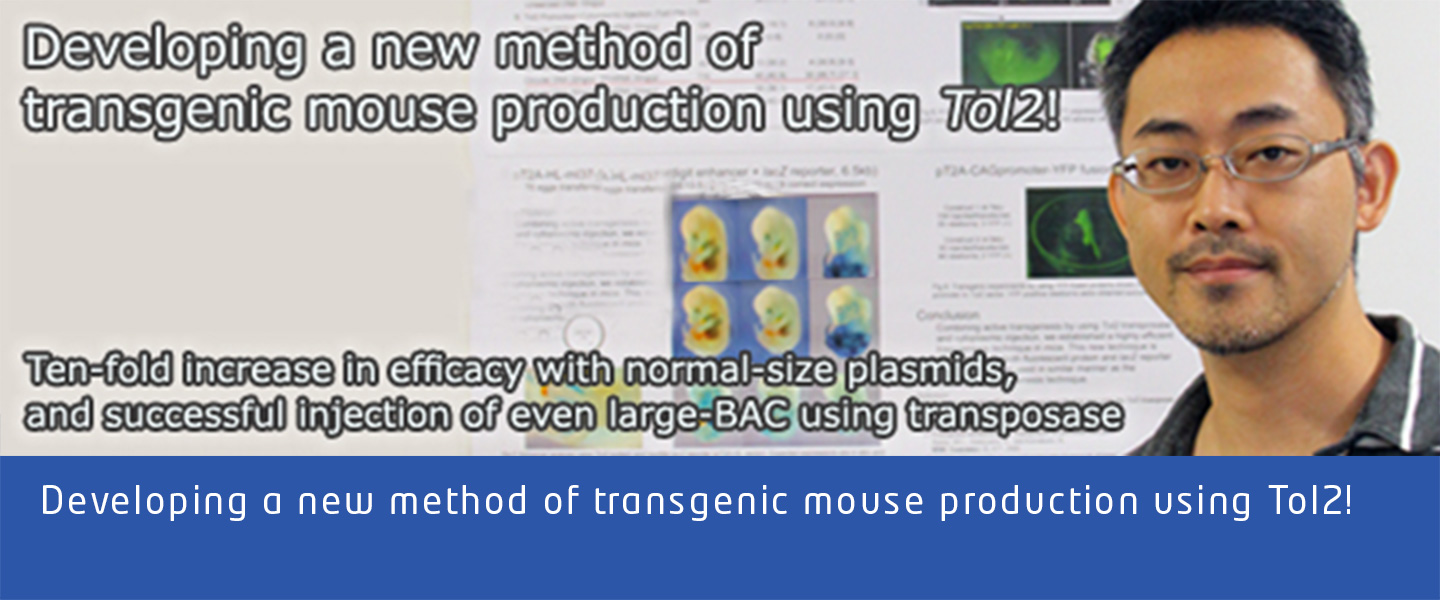Developing a new method of transgenic mouse production using Tol2!

Kenta SUMIYAMA, D. Sc., Assistant Professor,
Saitou Group, Division of Population Genetics,
Department of Population Genetics, National Institute of Genetics/ SOKENDAI.
How did you get into the development of transgenic mouse-producing technologies?
It all started with my encounter with mouse genetic engineering when I was in the United States from 1998 to 2003. Before that I was at the NIG, in Dr. Naruya Saitou’s Laboratory (Division of Evolutionary Genetics) to be precise, for my joint research in the doctoral program and later as a postdoc. I was studying molecular evolution, spending my days decoding DNA sequences and analyzing them on the computer. Then I got the opportunity to study as a postdoc in Frank Ruddle’s laboratory at Yale University. This laboratory succeeded for the first time in the world in producing transgenic mice. The laboratory was working on a new method involving the injection of large-size genes using BAC when I was there. During this period, I was able to carry out research using live individual organisms which I had always wanted to do. This experience gave me the idea of analyzing the function of genes closely related to evolution by using genetic engineering technologies.
Back in Japan, I rejoined Dr. Saitou’s lab. I started research applying genetic engineering methods while doing research into molecular evolution at the same time, that is, the way I do my research now. Saitou Laboratory conducts genomic-level comparative studies to find the answer to the ultimate question “how humans have become humans.” Comparing only the protein coding regions of genes does not reveal any definitive difference between humans and chimpanzees because the difference between the two is believed to lie in the way genes are used. How genes are used is determined by the transcription regulation region that is around genes. I wanted to apply new technologies to produce transgenic mice to elucidate the function of the transcription regulation region of mammals in order to solve the mysteries of evolution.
What are your latest research achievements?

The conventional transgenic mouse generation that involves injection into individual mice has an extremely low success rate of 2-3%. This is because the method necessitates pronuclear DNA injection, which tends to damage nuclei. So in our research project, we applied to mice the transposon-derived transposition enzyme (Tol2 transposase), which had already been used in zebrafish and produced positive results. In our research, we obtained two epoch-making outcomes (transposons can transpose themselves within the genome of an animal or plant cell). First, with relatively small but normal-size (below 10kb) plasmids, we performed cytoplasmic injection, instead of pronuclear injection as in the conventional method, and dramatically increased the injection rate to over 20%. The other positive result was that we proved that Tol2 transposase can efficiently transpose even huge BAC in mouse cells.
What worked well, specifically, to get such results?
First, I can cite the use of Tol2 in fertilized mouse eggs. Previously, Tol2 had been used in cultured mammalian cells, but never in fertilized mouse eggs to generate individuals. Second, it was vital that we broke free from the old belief in pronuclear injection of plasmid DNA and tried cytoplasmic injection. This turned out to be a major shift in our way of thinking. Scientists used to believe that with fertilized mouse eggs cytoplasmic injection did not allow DNA incorporation into the genome.
With these novel approaches, coupled with the highly efficient transposase, we dramatically improved the survival rate of fertilized eggs, from a few percentage points to a two-digit figure. The impact of this can be all the more accurately appreciated when we consider the following: when one researcher produces transgenic mice using the conventional method, he can analyze only about 20 genes per year so that the analysis will be statistically significant. With the new method we used, with its ten-fold increase in injection efficiency, the number of genes a single researcher can analyze shots up to 200. Since there are about 400 genes in the super-storage region known as the transcription regulation region of a mammal, two researchers sharing the task can complete their analysis in 12 months. This improvement enables more rapid and larger-scale research. This also means that even a small laboratory with a very limited budget can engage in this type of research, which can give great impact on the whole research community.

Where did you find the key to your ideas?
It was found nowhere but in the fact that I, someone who had done mouse genetic engineering, was able to work with Dr. Kawakami, who had succeeded in genetic injection into zebrafish using Tol2. At the NIG, there are various opportunities for interactions with other researchers such as in-house seminars, biological symposiums and poster sessions which often give rise to inter-lab discussions and collaborations. It was on one of such occasions that I met Dr. Kawakami and learned that he was doing joint research with researchers specializing in various model animals and was looking for someone capable of generating transgenic mice. So we agreed to work together. This happened also because I was singled out when one of Dr. Kawakami’s research partners, Dr. Kazuhiro Yagita (Osaka University), was looking for a researcher who could perform genetic injection into individual mice using Tol2.
It is not easy to adopt a new technology: it is obvious from the fact that roughly the same method has continuously been applied to transgenic mouse generation for 30 years. However, in our research, through repeated discussions we began to think that the use of Tol2 could largely improve injection efficiency, even with mice. Then, through repeated experiments, we came up with the idea of cytoplasmic injection, which turned out to be quite successful. This is how we dismantled the 30-year-old fixed idea that pronuclear injection was the norm for mice.
That is to say, you made the most of working at the NIG.
Exactly. I think that new discoveries and research achievements that break through conventional frameworks tend to come from small laboratories because it is possible to make small changes and work flexibly in small laboratories, which in turn makes it relatively easier to start daring research projects. Since the NIG has various laboratories, it has many opportunities for producing new ideas. The ideas I came up for our research also had the blessing of Dr. Saitou of my laboratory.
The other day, I presented the same research results at the Japan Society of Developmental Biologists meeting and received positive feedback from colleagues who were interested in using the same method. So we are planning on joint research projects with other research institutes using the method. Since it is a safe and widely applicable method, I believe it will become possible to apply it to livestock and in the medical field in the future.
What is your future goal?
I am planning to use the same method to conduct high-throughput analysis of transcription regulation genes. At the same time, I intend to continue and deepen interactions with other researchers within the NIG and do PR of the method as before.
(Interviewed by Naoko Nishimura on Jun. 30, 2010)
1) A simple and highly efficient transgenesis method in mice with the Tol2transposon system and cytoplasmic microinjection.
Sumiyama, K., Kawakami, K., and Yagita, K. Genomics 95(5) 2010. DOI: 10.1016/j.ygeno.2010.02.006
2) Transposon-mediated BAC transgenesis in zebrafish and mice.
Suster, M.L., Sumiyama, K., and Kawakami, K. BMC Genomics 10, 477, 2009. DOI: 10.1186/1471-2164-10-477
Back














